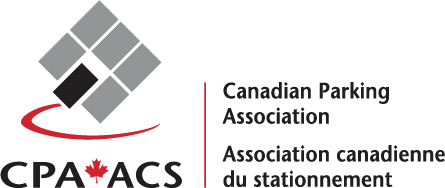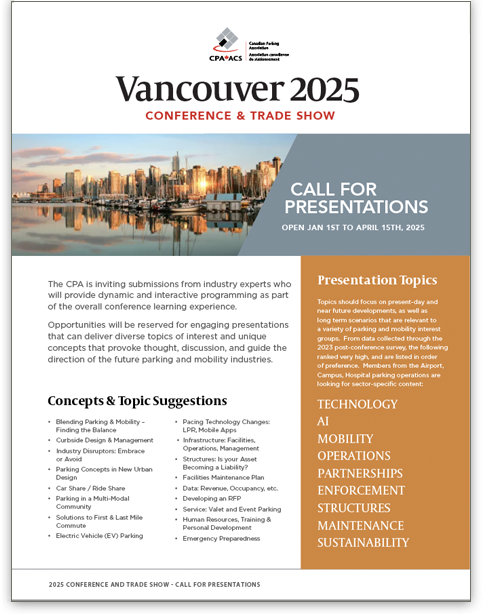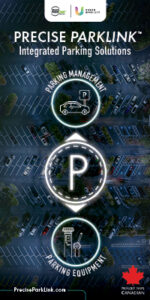Managing Parking Challenges Caused by Airport Expansion
By Stephen Prati
Canadian airports have been actively investing in infrastructure upgrades and expansion to enhance safety, operational efficiency, and accommodate growing air travel demand. Since the early 1990s, over $30 billion has been invested in airport infrastructure improvements. Parking has played an important role in these improvement projects.
The pace of this investment has accelerated in recent years. In response to the financial challenges posed by the COVID-19 pandemic, the Canadian government introduced the Airport Critical Infrastructure Program (ACIP) in 2021. This program has committed more than $570 million to 19 of Canada’s larger airports, supporting 39 critical infrastructure projects aimed at enhancing safety, security, and operational efficiency. Additionally, in May 2024, the government announced over $27 million in new funding to upgrade airports across the country, ensuring continued access to reliable and safe air connectivity for Canadians.
Airport terminal improvements are particularly prevalent. Currently, major airport terminal projects are underway at many of the country’s largest and busiest airports, including Toronto Pearson International, Kelowna International, Edmonton International, Montréal-Trudeau International Airport, and Calgary International Airports. It’s estimated that about $6 billion dollars are currently being spent on airport improvement projects throughout Canada.
For instance, Montréal-Trudeau International Airport is currently undergoing a $4 billion makeover that includes expanding roadways and drop-off areas and building a new terminal. As part of this improvement project, an existing 5,000-vehicle lot will be demolished to make room for the construction of expanded, multi-level drop-off and pick-up areas, effectively tripling the current curbside capacity at the airport’s main entrance. The lost parking spaces will be replaced through the construction of several new parkades located throughout the airport campus.
These improvement projects are good news for both airport administrators and travelers, but they also present tremendous challenges. It can be difficult to maintain normal operations while pursuing construction projects in and around terminals, particularly when it comes to parking. Airports, especially in densely developed urban areas, tend to be landlocked, with limited land to expand onto, and parking facilities have traditionally offered the most attractive places. Airport planners have learned that by developing parking up, rather than out, they can fit more cars on a smaller footprint. As such, terminals can be expanded onto adjacent parking lots, with lost parking spaces replaced with new parking structures. Likewise, parkades can serve the same volume of parking if they are replaced by new structures that are taller, yet less wide, requiring a smaller footprint. The land that’s regained can then be used for terminal expansion.
Impacts and Solutions
As sensible as these planning approaches are, they do impact parking. For instance, when new parking facilities are being constructed, they must remain operational. Airports can’t afford to lose parking revenue during construction projects. Phased construction is often the order of the day, with parking still being provided in areas that remain open. And when newly configured parking facilities are open, travelers may have difficulty navigating unfamiliar parking facilities and be hesitant to use those parkades.
When airports lose parking spaces, even if the loss is only temporary, they need to be creative about how they sell those spaces. They want to make sure that travelers feel comfortable using newly reconfigured parking facilities and they also want to increase occupancy to the highest levels possible to maximize parking revenues. Parking reservations—or prebooking—programs can help achieve both ends.
Navigating Parking Constraints During Construction
First comes customer service. When airport parking operations are impacted by construction, travelers may be hesitant to park in affected parkades and lots. Travelers are typically on a very tight schedule trying to make a flight, and they can’t afford to take a chance on their search for a parking space being fruitless. But a parking reservations platform can eliminate that risk. When travelers can reserve a parking space in advance, before they leave for the airport, the uncertainty over whether they’ll be able to find parking is eliminated. This is an important customer service amenity that dramatically improves the parking experience.
Enhancing the Traveler Experience Through Reservations
Here’s how the process works. Before the traveler leaves for the airport, they log into the airport’s parking reservations web portal, which is generally connected to a dedicated parking pre-booking platform. Returning customers merely sign into their existing account and are guided through the process of reserving a parking space. Guest users can also pre-book a space via a simple 3 step bookbinder process. If they like, they can create an account to simplify the process next time they log in to reserve a space. When creating an account, they will add a credit card along with their personal information.
When a parking session is booked, the driver is issued a bar code. That bar code can be printed or used on a mobile device, and it is scanned when entering and exiting the parking garage. Some airports utilize license plate recognition technology (LPR) to identify the vehicle, thus eliminating the need for bar codes altogether. When the travelers return from their trip and exit the airport parking facility, they just drive out as payment is made at the time of the reservation. The booking process itself is simple and easy, and entering and exiting the garage is a breeze.
Systems can even be set up to manage permit parking for drivers who fly regularly, and a pre-booking platform can even be used to manage an airport’s parking loyalty program. Loyalty programs are a great way to encourage travelers to rely on airport parking facilities for future trips, and airports can set up these programs to offer any type of award, including special parking rates and locations, discounts at in-terminal restaurants and stores, and other add-on services.
The Role of Pre-booking in Maximizing Occupancy
This same process benefits airports by maximizing occupancy. Parking is a significant source of revenue for airports and it’s essential to maximize occupancy, filling as many operational spaces as possible when parking operations are impacted by construction. When travelers are assured that there’s an available parking space, they are more likely to use airport parking facilities, and this means more revenue for airports.
Administrative Benefits
The benefits provided by a pre-booking platform don’t end with the parking transaction. The technology can also provide important administrative advantages to airport parking managers, giving them more control over their parking inventory by permitting them to assign specific parking spaces or areas to individual users. They can also facilitate the creation and management of premium services, such as VIP or valet parking.
Ultimately, pre-booking platforms can help generate additional revenue for the airport. In addition to providing access to premium parking services, platforms can also be set up to offer add-on services, such as vehicle detailing, flower delivery, and even dry-cleaning services (travelers just leave their clothes and when they return the cleaned clothes are already stored in the vehicle). Additionally, airports can set up platforms to allow businesses in the terminal, such as restaurants and bookstores, to offer pre-booking parkers access to specials and other deals, which can be offered via the platform.
Lastly, a parking pre-booking platform also permits airport parking administrators to better manage airport parking facilities by providing real-time data about who is parking in certain areas, on what day, and when they tend to arrive and leave each day. This can be extremely helpful data for better managing airport parking facilities.
Helping Manage Challenges
Pre-booking technology has been an essential element of airport management since the 1990s, helping to improve the parking experience for travelers and manage airport parking assets more effectively and efficiently. Now, when airport parking is impacted by construction caused by expansion projects, pre-booking can help airports manage their parking assets more efficiently and maximize parking revenues.
As airports continue to expand, the future of parking will rely on automation, predictive demand forecasting, and personalized services. Tools like AI-driven pre-booking, license plate recognition, and frictionless payments will streamline operations, while tailored parking recommendations and loyalty integrations will enhance traveler confidence. By leveraging these innovations, airports can minimize disruptions and maximize revenue, all while turning parking into a seamless extension of the passenger experience.
About the author:
Stephen Prati is Deputy Managing Director of Chauntry. He can be reached at Stephen.Prati@chauntry.com.






